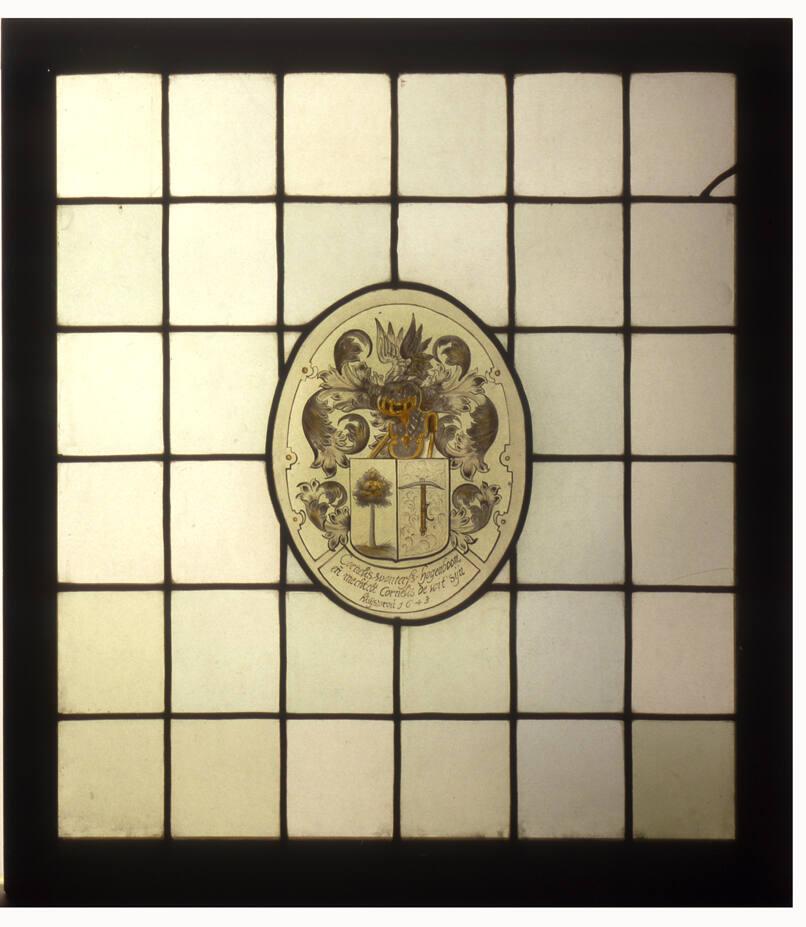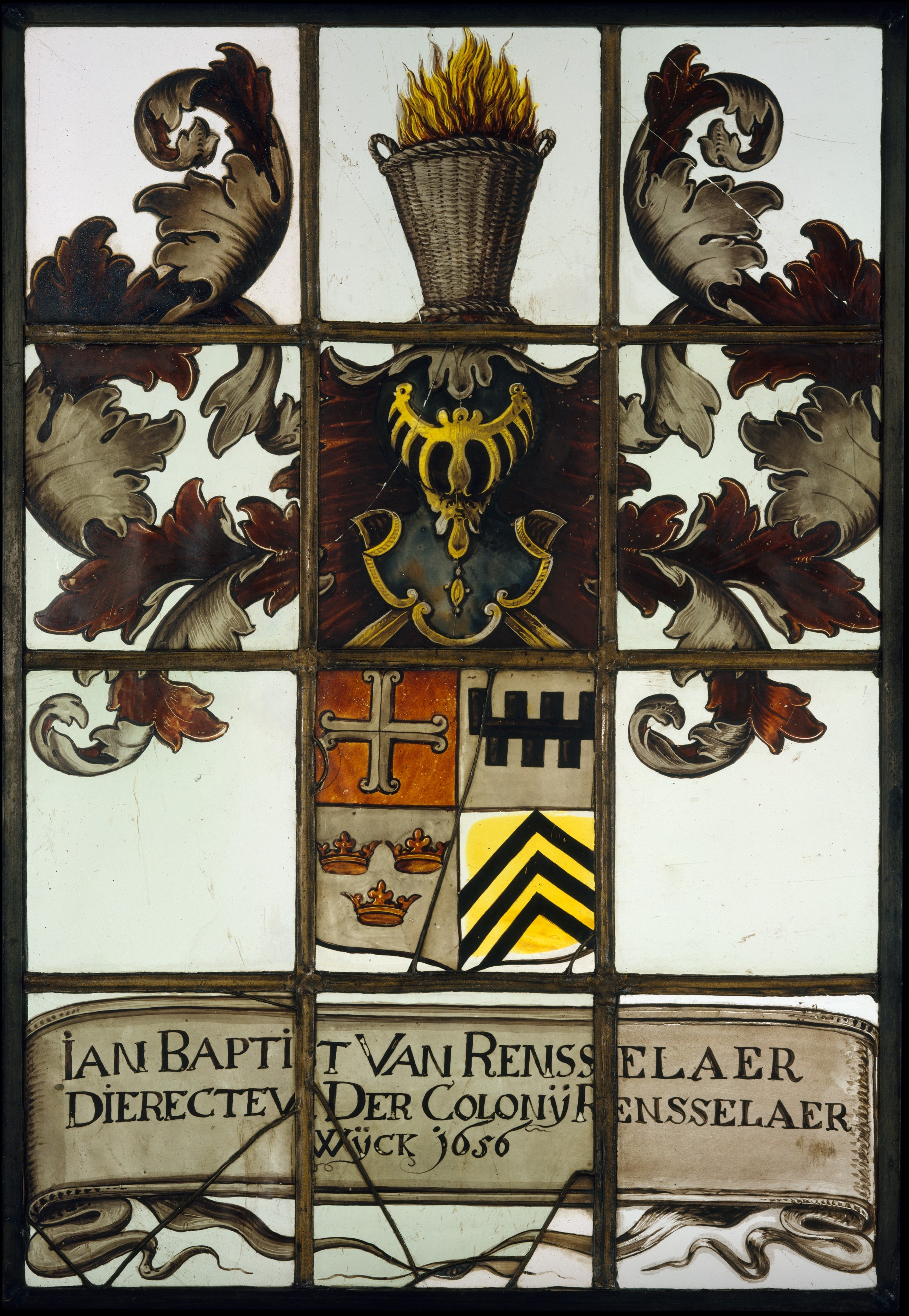
Artist/Maker Evert Duyckinck I (1621 - ca. 1703)
Collection of New York Historical Society - Stained glass window ca. 1656 Place Made New York, United States, North America Glass
Overall: 30 1/2 x 27 1/4 x 1 in. ( 77.5 x 69.2 x 2.5 cm )
Gift of Mrs. Howard C. Robbins 1951.414c
This is one of a small group of stained glass windows attributed to Duyckink that are thought to have been made for the First Reformed Dutch Church built in Albany, New York, in 1656 and torn down in 1715. This window was removed from a house on Eighth St. in New York City and found by Mrs. Howard Robbins in a wrecker's yard and used in her Dutch Revival house at Sneden's Landing on the Hudson.

Courtesy of the Metropolitan Museum of Art
Met Museum Summary: Evert Duyckinck was one of the earliest artists in glass in this country. When he immigrated with his family to New Amsterdam in 1638, he was recorded in historic documents variously as a “glass stainer,” or a “limner.” This window, which is decorated with the Van Rensselaer coat of arms, was one of several armorial panels given in 1656 to the First Dutch Reformed Protestant Church of Beverwyck (present-day Albany), New York. The donor of this example was Jan Baptist Van Rensselaer, director of the large estate known as Rensselaerwyck. After the church was demolished in 1805, the window was installed at the head of the staircase in the Van Rensselaer Manor House. The entry hall from that house can be seen on the second floor of the American Wing (gallery 752).
Maker: Evert Duyckinck (American (born Netherlands), ca. 1620–1700)
Date: ca. 1656 Geography: Made in New York, New York, United States
Medium: Painted leaded glass
Dimensions: Framed: 22 3/8 x 15 1/2 in. (56.8 x 39.4 cm)
Object Number: 52.77.46 https://www.metmuseum.org/art/collection/search/9817
| Spouse | Marriage |
|---|---|
| Hendrickje Simons (ID: 660,044) | 100 - 660,044 Duyckingh-Simons |
See Lot M12 for Stokes Biographical Information for a discussion of Evert's work in creating stained glass windows for the Church in New Amsterdam and in Albany.
…very likely the smaller house was built with every comfort known to the times; for Duyckingh was a prosperous man in 1656, when he bought this lot from Richard Smith….
Evert's Biography according to Stokes:
Evert Duyckingh's grant, of 1643, had a frontage on the road of 10 rods, 2 feet, 2 inches, and 4 grains-—-calculated roughly, about 127 feet. It comprised numbers 16 to 26 South William Street, and was irregular in shape. The house, nearly thirty feet wide, covered N o . 22 and part of No . 20.
Evert Duyckingh, of Borcken, in Westphalia, was born about 1621, according to a deposition made by him Ma y 11 , 1657.-—Min. of Orph. Court, I: 32. He was employed by the West India Company at Fort Good Hope on the Connecticut, as early as 1640-41. He and Gysbert Opdyck were viciously attacked by the English settlers there, when Duyckingh, while ploughing, was cut "in the head with an adze stuck in a long handle, so that blood ran down his face and clothes."—N. Y. Col. Docs., II: 141-3 . He was a mere youth at that time ; yet he, evidently, had learned the glazier's trade in Germany.
At any rate, he was a master glazier in 1648, when Cornelis Jansen was apprenticed to him.—Cal. Hist. MSS., Dutch, 44. He is referred to, in 1658, as a "glass-maker."—Libe r Deeds, A : 132. The Labadists came over with Evert Duyckingh, Junior, who was the mate of the "Charles. " They record: "The y had built a new church in the Hysopus, of which the glass had been made and painted in the city, by the father of our mate, Evert Duiken, whose other son, Gerrit, did most of the work . . . He promised to teach me how to draw."— Murphy's Journal of a Voyage to New York (etc.), by Jaspar Dankers and Peter Sluyter, 276. Mr. Murphy, in a note, says: "By the phrase, making the glass, we apprehend glazing is all that is meant by our journalist." But the traveller meant what he said. Both Evert Duyckingh and his son, Gerrit, undoubtedly, understood the art of painting glass, which required the use of a kiln for firing. As late as 1687 and 1700, the records refer to the fact. Evert Duyckingh, Senior, is called a "limner, " and Gerrit Duyckingh a "painter, " and also a glazier, in grants to them of land under water in front of their lands in Block P.—• Liber A: 52, 300; ibid., B : 133, in Comptroller's Office.
The townspeople and Jasper Danckaerts may not have differentiated between "making " the glass itself and "making " the finished product—the beautiful emblazoned windows of coloured glass for churches and for the homes of the wealthier citizens. It is an interesting fact that this art was practised in New Amsterdam so early.
Before the survey of 1657, the Slyck Steegh was an impasse. It ended at Burger Jorissen's line fence, as the Plan correctly shows. On Thursday, April 19, 1657, the neighbours in the Glaziers Street petitioned "for a cart wa y to the Strand, as was promised them. " They were told: "As soon as the general survey is made, further attention shall be paid to the petitioners' request, that a suitable road be made."—Rec . N. Am., VII : 156. Then was the little lane or "gangetje " cut through, and the Smee Straet, or William Street, extended (see Block Q, No . 16). The Mill Street of later years, now South William Street, ended just at the side of the lane. It was not extended to William Street until 1835. "The Slick Steegie where Evert Duijckingh lives," as de Sille announced in 1660, later became an undesirable place of residence. The house was sold, on February 3, 1674, to Jacob Melyn, whose attorney resold it to Dr. Johannes Kerfbyl, Ma y 28, 1697.—Liber Deeds, XXI : 221. Evert Duyckingh's wife was Hendrickje Simons. They were married on August 28, 1646.—Marriages in Ref. Dutch Ch., 14. On December 19, 1728, Cornelius Clopper and wife sold the plot where Duyckingh's house had stood, 40 feet wide on the Mill Street, to the trustees for the Jewish congregation, Lewis and Mordecay Gomez, Jacob Franks, and Rodrigo Pacheco.—Liber Deeds, XXXI : 263. Here was erected the first synagogue built especially for Jewish worship, although the Jewish congregation had been worshipping in the city for many years—in a house belonging to Jan Harpendingh (see No. 13, infra.). The synagogue property covered No. 22 and parts of Nos. 20 and 24 South William Street.

